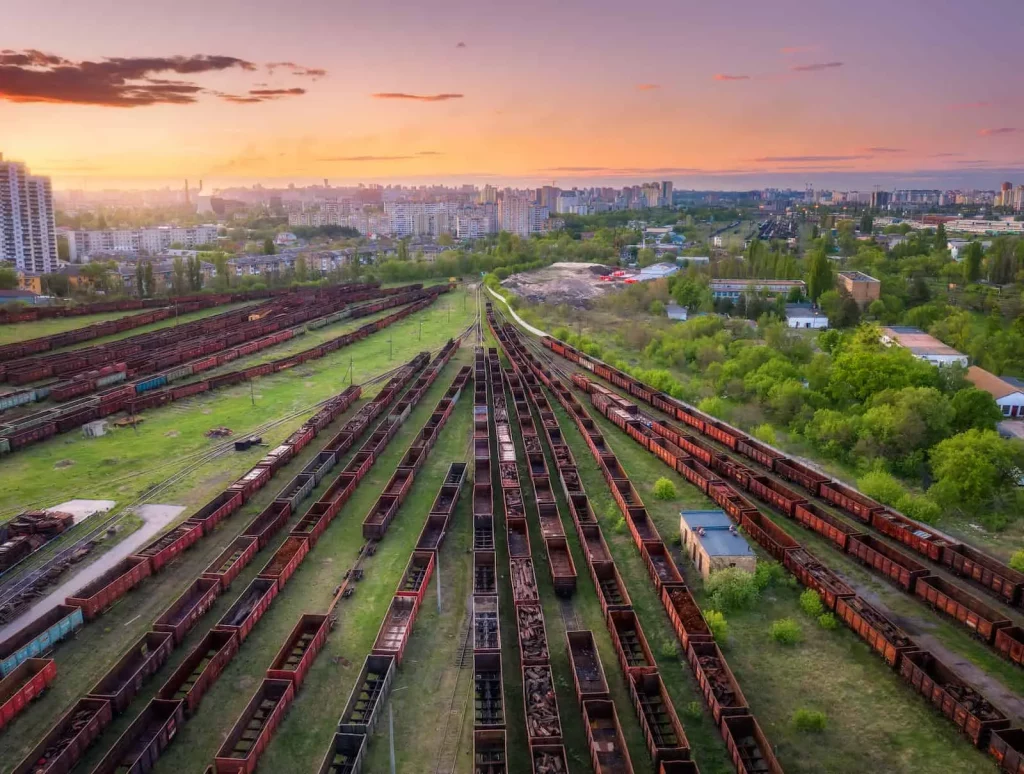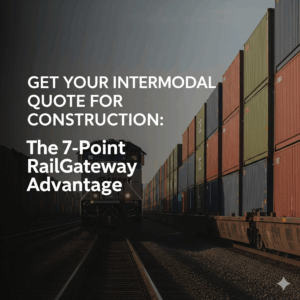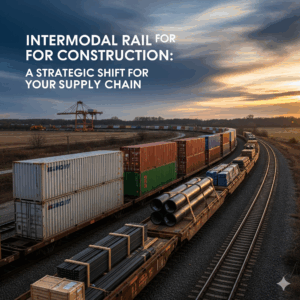This post was last updated on May 22nd, 2025
In today’s rapidly evolving logistics landscape, intermodal transport has become the gold standard for efficient, reliable, and cost-effective shipping in 2025. Whether you’re a seasoned supply chain professional or just stepping into the world of freight movement, understanding intermodal transport is the key to staying competitive. This powerful shipping method combines multiple transportation modes—typically truck, rail, and sometimes ocean—under a single shipment process. It enables companies to take full advantage of each mode’s strengths while reducing costs and minimizing delays.
Intermodal transport is more than a buzzword—it’s a strategic approach to logistics that can transform how businesses move goods across vast distances. With rising fuel costs, driver shortages, and increasing pressure to reduce carbon emissions, businesses are turning to intermodal transport to meet environmental, economic, and customer satisfaction goals. It’s no surprise that intermodal freight volumes have surged in recent years, with 2025 projected to be one of the biggest growth years yet for this mode of transport.
At its core, intermodal transport simplifies logistics. Goods are loaded into standardized containers or trailers and moved seamlessly from trucks to trains (and vice versa) without ever needing to be unpacked. This seamless transition is one of the biggest advantages of intermodal shipping—it preserves product integrity, reduces labor costs, and decreases the risk of damage or theft. With visibility and tracking technologies now integrated into every phase of the journey, intermodal transport offers a level of control and transparency that’s essential for modern supply chains.
The growing popularity of intermodal transport is also fueled by infrastructure improvements across North America. In Canada, massive investments in intermodal terminals and rail corridors are streamlining east-west and cross-border trade. Ports are expanding intermodal capabilities, rail companies are upgrading equipment, and logistics providers are offering better route optimization—all of which make intermodal transport faster, safer, and more predictable than ever before.
For shippers who prioritize reliability and sustainability, intermodal transport checks every box. Trains, for example, are significantly more fuel-efficient than trucks—moving one ton of freight nearly 500 miles on a single gallon of fuel. By shifting a portion of long-haul freight from roads to rails, companies can dramatically reduce their environmental footprint while avoiding the headaches of congested highways and inconsistent driver availability.
Another compelling reason why intermodal transport is booming in 2025 is its resilience. With weather disruptions, labor strikes, and geopolitical tensions affecting global logistics, having a flexible multi-modal system gives businesses the agility they need. Intermodal transport offers built-in redundancy and multiple route options, helping to maintain continuity even when unexpected events strike.
In the age of smart logistics, intermodal transport is also becoming more data-driven. Real-time tracking, predictive analytics, and AI-powered optimization tools are giving logistics managers unprecedented control over every leg of a shipment. With the ability to anticipate delays, reroute shipments, and update customers in real time, intermodal transport supports not only operational efficiency but also outstanding customer service.
Whether you’re shipping across Canada, to the U.S., or managing a global supply chain, intermodal transport is a tool you can’t afford to ignore. It’s efficient, secure, sustainable, and scalable. In this guide, we’ll walk you through everything you need to know to master intermodal transport in 2025—from the basics and benefits to step-by-step instructions for building an intermodal shipping strategy tailored to your business.

Intermodal vs. Multimodal
Thinking, “Wait, shouldn’t this be about multimodal transport?” and wondering why I’m saying “intermodal”? Are they even the same? Great questions! The answer is no; they’re not exactly the same.
A widespread misconception is that intermodal and multimodal transportation are identical. However, moving a box with various vehicles—such as trucks, trains, and ships—without opening the box is known as intermodal transport.
And for multimodal, imagine you’re sending a box across the country. The box might travel on a truck, then a train, and finally a smaller truck for delivery, but the items inside always stay inside the box.
To sum it up,
| Features | Intermodal Transport | Multimodal Transport |
| Load Unit | Standardized | Non – Standardized |
| Management of Cargo | One operator Manages | Multiple Operators Manage |
| Load Unit change during transit | No | Yes |
| Method of Transport | Two or More | Two or more |
What Actually Is Intermodal Transportation?
Intermodal transport is the use of two or more modes of transportation to move goods from origin to destination, typically without handling the freight itself when switching between modes. This method relies on standardized containers or trailers that can seamlessly transfer between truck, rail, ship, or even air. In most intermodal transport scenarios, goods are first loaded onto a truck, moved to a rail terminal, transported via train over long distances, and then delivered by truck to the final destination.
The primary appeal of intermodal transport lies in its efficiency. By combining modes—especially the long-haul cost-efficiency of rail with the flexibility of road transport—shippers reduce fuel consumption, lower emissions, and mitigate highway congestion. This makes intermodal transport not only a smart financial choice but a sustainable one as well.
In 2025, intermodal transport has become a cornerstone of global supply chain logistics. Technological advancements in tracking, route optimization, and automated scheduling have made intermodal logistics more precise and accessible. Whether you’re shipping across provinces in Canada or managing international routes, intermodal transport provides reliable, scalable solutions for businesses of all sizes. As infrastructure continues to evolve, adopting intermodal transport offers shippers a competitive edge in cost control, environmental responsibility, and delivery performance.
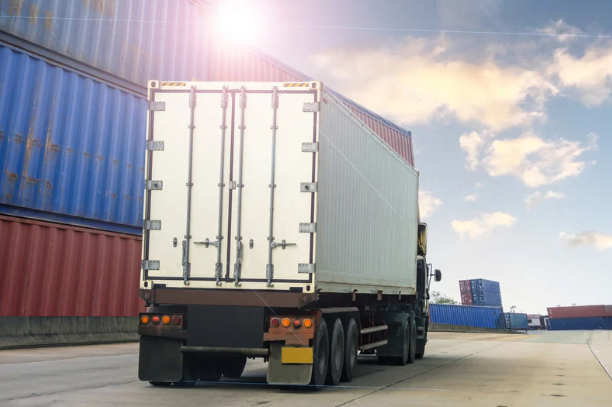
The Methods of Intermodal Transport
There are mainly four modes of transference for intermodal transport. They are:
- Truck Intermodal Transportation
Truckload shipping is the primary method of moving shipments overland. Trucks play a crucial role in intermodal shipping. They pick up goods from their origin point and transport them to the first leg of the journey, like a port or rail yard. The trucks deliver the goods to the customer once the intermodal container reaches its final destination.
- Rail Intermodal Transportation
Trains, as opposed to truckloads, are a more efficient mode of land transportation. Because it is the least expensive and fastest approach available on the ground. They can transport hundreds of intermodal containers over long distances. In a timely and effective manner.
- Air Freight Intermodal Transportation
Airfreight intermodal transportation involves planes transporting containers across oceans and regions. This can be the best deal because it provides the highest reliability for urgent deliveries at the lowest cost.
- Sea or Ocean Freight Intermodal Transport
Have you ever wondered how that device arrived from overseas? Most likely, it boarded a massive ship! Large volumes of cargo may be transported across seas with ocean freight. which makes it reliable and reasonably priced for international shipping.
The carriers involved offer various types of services, such as less container load (LCL) and full container load (FCL). While FCL involves using a whole container for a single shipment,. This means that LCL is more cost-effective for smaller cargo volumes, while FCL is better for larger shipments.
Unlocking Efficiency: Why Intermodal Transport is Growing
Moving goods around the globe can be accomplished with intermodal transportation. Which is the smooth integration of two or more modes of transportation (such as truck, rail, and ship). There are many advantages to it. They are –
- Increased Cost-Effectiveness
Because there is no chance of congestion, fuel expenses are reduced. In general, ships and trains use very little gasoline. Causing significant long-distance transportation cost savings. Furthermore, given the already existing and upkeep of the rail and shipping networks. There are no additional maintenance or building expenses.
When containers are used correctly, very little loading and unloading occurs. Leading to a very small quantity of lost space.
- Environmental Sustainability
Rail transportation offers a more sustainable mode of freight shipment compared to traditional trucking. By producing significantly fewer greenhouse gases per ton of cargo transported.
Companies are adopting environmentally friendly practices and achieving a greener supply chain. Furthermore, as indicated earlier, the essential fuel efficiency of rail operations. Results in a considerable reduction in resource consumption, positively impacting environmental sustainability.
- Reliability and Efficiency
Due to the lack of congestion, all shipments are planned to depart on time. As a result, delays are reduced, and delivery rates improve.
If the containers are appropriately optimized, as was previously mentioned. Between the origin and the destination, there will be fewer handling locations visible. Resulting in shorter transit times overall and a lower chance of damage.
Intermodal options provide facilities for different freight volumes. Allowing you to ship flexibly, regardless of the size.
- Security and Safety
The intermodal containers used for shipping cargo are very robust and durable. Which offers safekeeping and defense all along the way. Additionally, advanced real-time tracking is included for extra functionality.
Because these multimodal transportations spend very little time on vulnerable routes. The chances of theft are greatly reduced.
Additional advantages include benefits like reaching deeper and farther into territories. That would have been impossible with the likes of Trucks and other road based vehicles
Parting Words
In today’s rapidly evolving logistics landscape, intermodal has become the gold standard for efficient, reliable, and cost-effective shipping in 2025. Whether you’re a seasoned supply chain professional or just stepping into the world of freight movement, understanding intermodal transport is the key to staying competitive. This powerful shipping method combines multiple transportation modes typically truck, rail, and sometimes ocean -under a single shipment process. It enables companies to take full advantage of each mode’s strengths while reducing costs and minimizing delays.
Intermodal transport is more than a buzzword – it’s a strategic approach to logistics that can transform how businesses move goods across vast distances. With rising fuel costs, driver shortages, and increasing pressure to reduce carbon emissions, businesses are turning to intermodal transport to meet environmental, economic, and customer satisfaction goals. It’s no surprise that intermodal freight volumes have surged in recent years, with 2025 projected to be one of the biggest growth years yet for this mode of transport.
At its core, intermodal simplifies logistics. Goods are loaded into standardized containers or trailers and moved seamlessly from trucks to trains (and vice versa) without ever needing to be unpacked. This seamless transition is one of the biggest advantages of intermodal shipping – it preserves product integrity, reduces labor costs, and decreases the risk of damage or theft. With visibility and tracking technologies now integrated into every phase of the journey, intermodal offers a level of control and transparency that’s essential for modern supply chains.
The growing popularity of intermodal is also fueled by infrastructure improvements across North America. In Canada, massive investments in intermodal terminals and rail corridors are streamlining east-west and cross-border trade. Ports are expanding intermodal capabilities, rail companies are upgrading equipment, and logistics providers are offering better route optimization – all of which make intermodal transport faster, safer, and more predictable than ever before.
For shippers who prioritize reliability and sustainability, intermodal checks every box. Trains, for example, are significantly more fuel-efficient than trucks—moving one ton of freight nearly 500 miles on a single gallon of fuel. By shifting a portion of long-haul freight from roads to rails, companies can dramatically reduce their environmental footprint while avoiding the headaches of congested highways and inconsistent driver availability.
Another compelling reason why intermodal is booming in 2025 is its resilience. With weather disruptions, labor strikes, and geopolitical tensions affecting global logistics, having a flexible multi-modal system gives businesses the agility they need. Intermodal offers built-in redundancy and multiple route options, helping to maintain continuity even when unexpected events strike.
In the age of smart logistics, intermodal is also becoming more data-driven. Real-time tracking, predictive analytics, and AI-powered optimization tools are giving logistics managers unprecedented control over every leg of a shipment. With the ability to anticipate delays, reroute shipments, and update customers in real time, intermodal supports not only operational efficiency but also outstanding customer service.
Whether you’re shipping across Canada, to the U.S., or managing a global supply chain, intermodal is a tool you can’t afford to ignore. It’s efficient, secure, sustainable, and scalable. In this guide, we’ll walk you through everything you need to know to master intermodal in 2025—from the basics and benefits to step-by-step instructions for building an intermodal shipping strategy tailored to your business.
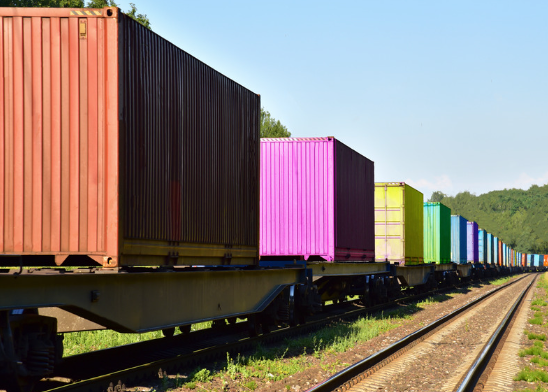
FAQ’s
- What is intermodal transport and how does it work?
Intermodal transport is a method of shipping goods using two or more transportation modes—such as trucks, trains, and ships—without handling the freight itself when switching between modes. - Why is intermodal transport more efficient than road-only shipping?
Intermodal leverages rail for long-haul segments, which is more fuel-efficient and cost-effective than road transport alone. - Is intermodal transport cost-effective for small businesses?
Yes, intermodal has become increasingly accessible to small businesses through partnerships with 3PLs and freight brokers who consolidate shipments. - How does intermodal transport reduce environmental impact?
Intermodal significantly lowers greenhouse gas emissions by reducing reliance on long-distance trucking and increasing the use of rail, which is more eco-friendly. - What type of freight is best suited for intermodal transport?
Intermodal works best for non-perishable, high-volume freight that doesn’t require ultra-fast delivery but needs dependable, cost-efficient shipping. - Can intermodal transport handle international shipping?
Absolutely. Intermodal transport integrates seamlessly with ports and customs, making it ideal for cross-border and global freight movement. - Is intermodal transport slower than full truckload (FTL) shipping?
While it may take slightly longer than FTL, intermodal transport is often more predictable due to fewer road-related disruptions and optimized rail schedules. - What infrastructure is required for intermodal transport?
Intermodal transport depends on access to terminals, railyards, and transfer facilities that can handle containerized freight across different modes. - How secure is intermodal transport compared to other methods?
Intermodal transport is highly secure, especially since containers remain sealed throughout the journey, reducing the risk of damage or theft. - Can I track my shipments during intermodal transport?
Yes, modern intermodal transport systems include real-time tracking technologies that allow shippers to monitor cargo at every stage. - How do I get started with intermodal transport for my business?
Begin by consulting a logistics provider or 3PL experienced in intermodal transport. They can evaluate your routes and determine the most efficient modal mix. - What are the long-term benefits of switching to intermodal transport?
Intermodal transport improves shipping reliability, lowers transportation costs, supports sustainability goals, and reduces risk in times of driver shortages or fuel volatility.
Additional Resources
- Federal Motor Carrier Safety Administration – Intermodal Freight Transportation https://www.fmcsa.dot.gov/safety/intermodal-freight-transportation
- American Association of Railroads – Intermodal
https://www.aar.org/issue/intermodal/ - U.S. Department of Transportation – Benefits of Intermodal Shipping https://www.transportation.gov/policy-initiatives/benefits-intermodal-transportation
- Supply Chain Dive – How intermodal shipping improves supply chain efficiency https://www.supplychaindive.com/news/intermodal-shipping-supply-chain-efficiency/567123/
- Federal Highway Administration (FHWA) – Intermodal Freight Transport
Overview of intermodal freight concepts and infrastructure in the U.S.
https://ops.fhwa.dot.gov/freight/intermodal/index.htm - Transport Canada – Freight Transportation System
Detailed information on Canada’s multimodal freight system.
https://tc.canada.ca/en/services/freight - Bureau of Transportation Statistics (BTS) – Intermodal Transportation Database
Access government-collected data on intermodal freight movement.
https://www.bts.gov/freight-transportation - Journal of Commerce (JOC) – Intermodal Shipping News
Industry news and innovations in the intermodal shipping sector.
https://www.joc.com/rail-intermodal - Canadian National Railway (CN) – Intermodal Services Overview
See how CN handles intermodal containers and the advantages of rail.
https://www.cn.ca/en/our-services/intermodal/
How We Can Help
For businesses looking to optimize their freight shipping with reliable, efficient, and cost-effective solutions, RailGateway.ca is your trusted partner in intermodal logistics. Whether you’re new to freight trains or want to enhance your existing supply chain, our team of intermodal experts is ready to guide you every step of the way.
Contact RailGateway.ca today for a free quote or to speak directly with one of our experienced intermodal specialists. Let us help you unlock smarter, smoother shipping solutions tailored to your unique needs.
Visit RailGateway.ca or call us to get started on transforming your freight shipping strategy in 2025 and beyond.

